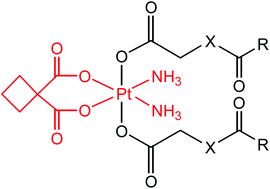Novel tetracarboxylatoplatinum(iv) complexes as carboplatin prodrugs†
Abstract
It is widely accepted that platinum(IV) complexes act as

* Corresponding authors
a
University of Vienna, Institute of Inorganic Chemistry, Waehringer Strasse 42, A-1090 Vienna, Austria
E-mail:
mathea.galanski@univie.ac.at, bernhard.keppler@univie.ac.at
Fax: +43-1-4277-52680
Tel: +43-1-4277-52601
It is widely accepted that platinum(IV) complexes act as

 Please wait while we load your content...
Something went wrong. Try again?
Please wait while we load your content...
Something went wrong. Try again?
H. P. Varbanov, S. M. Valiahdi, C. R. Kowol, M. A. Jakupec, M. S. Galanski and B. K. Keppler, Dalton Trans., 2012, 41, 14404 DOI: 10.1039/C2DT31366A
To request permission to reproduce material from this article, please go to the Copyright Clearance Center request page.
If you are an author contributing to an RSC publication, you do not need to request permission provided correct acknowledgement is given.
If you are the author of this article, you do not need to request permission to reproduce figures and diagrams provided correct acknowledgement is given. If you want to reproduce the whole article in a third-party publication (excluding your thesis/dissertation for which permission is not required) please go to the Copyright Clearance Center request page.
Read more about how to correctly acknowledge RSC content.
 Fetching data from CrossRef.
Fetching data from CrossRef.
This may take some time to load.
Loading related content
